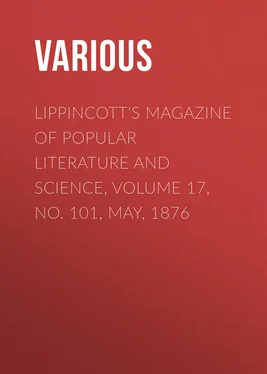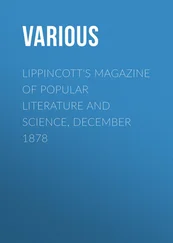Various - Lippincott's Magazine of Popular Literature and Science, Volume 17, No. 101, May, 1876
Здесь есть возможность читать онлайн «Various - Lippincott's Magazine of Popular Literature and Science, Volume 17, No. 101, May, 1876» — ознакомительный отрывок электронной книги совершенно бесплатно, а после прочтения отрывка купить полную версию. В некоторых случаях можно слушать аудио, скачать через торрент в формате fb2 и присутствует краткое содержание. Издательство: Иностранный паблик, Жанр: foreign_antique, periodic, foreign_edu, на английском языке. Описание произведения, (предисловие) а так же отзывы посетителей доступны на портале библиотеки ЛибКат.
- Название:Lippincott's Magazine of Popular Literature and Science, Volume 17, No. 101, May, 1876
- Автор:
- Издательство:Иностранный паблик
- Жанр:
- Год:неизвестен
- ISBN:нет данных
- Рейтинг книги:3 / 5. Голосов: 1
-
Избранное:Добавить в избранное
- Отзывы:
-
Ваша оценка:
- 60
- 1
- 2
- 3
- 4
- 5
Lippincott's Magazine of Popular Literature and Science, Volume 17, No. 101, May, 1876: краткое содержание, описание и аннотация
Предлагаем к чтению аннотацию, описание, краткое содержание или предисловие (зависит от того, что написал сам автор книги «Lippincott's Magazine of Popular Literature and Science, Volume 17, No. 101, May, 1876»). Если вы не нашли необходимую информацию о книге — напишите в комментариях, мы постараемся отыскать её.
Lippincott's Magazine of Popular Literature and Science, Volume 17, No. 101, May, 1876 — читать онлайн ознакомительный отрывок
Ниже представлен текст книги, разбитый по страницам. Система сохранения места последней прочитанной страницы, позволяет с удобством читать онлайн бесплатно книгу «Lippincott's Magazine of Popular Literature and Science, Volume 17, No. 101, May, 1876», без необходимости каждый раз заново искать на чём Вы остановились. Поставьте закладку, и сможете в любой момент перейти на страницу, на которой закончили чтение.
Интервал:
Закладка:
"Dusty," did we say? The ceaseless sob of engines that rob the Schuylkill daily of six millions of gallons to sprinkle over asphaltum, gravel and greensward demands recantation of the word. Everything has been foreseen and considered, even the dust of the earth. George's Hill Reservoir can, on occasion, give the pumps several days' holiday, and keep all fresh and dewy as the dawn.
Some industries meet us in the Centennial list that are not to be detected in the United States census or any other return we are acquainted with. What train of ideas, for example, is suggested to the average reader by the Roll-Chair Company? The rolling-stock of this association turns out, on inquiry, to be an in-door variety of the conveyance wherein Mrs. Skewton was wont to take the air under the escort of Major Bagstock. It is meant for the relief of those who wish to see everything in the Main Building without trudging eleven miles. Given an effective and economical motive-power, the roll-chair system would seem to meet this want. The reader of Dombey and Son will recollect the pictorial effect, in print and etching, of the popping up of the head of the propellent force when Mrs. S. called a halt, and its sudden disappearance on her directing a resumption of movement. The bobbing up and down of four hundred and fifty heads, like so many seals, will impart a unique aspect to the vista from one of the interior galleries of the great hall. The stipulated tax of forty dollars on each of these vehicles will necessitate a tolerably active undulation of polls if the company is to make both ends meet—granting that a rotatory movement can have an end.
Another startling item is the pop-corn privilege. A business-man of Dayton, Ohio, finds himself justified in venturing the heavy sum of seven thousand dollars on this very light article. Parched corn was well known in Ohio in 1776. The Miamis and Shawnees had, however, a monopoly of it. It composed their commissariat for a campaign against the whites. Such is the progress of the century.
This explosive cereal does not satiate the proverbially sweet tooth of our people. Their craving for confectionery is laid under further contribution by the financial managers of the exposition to the tune, for instance, of five thousand dollars for the privilege of manufacturing chocolate and candy. Dyspepsia insists on asserting its position among the other acquisitions of the century. The treasures of the American bonbonnière are said to be richer and more varied than in any other country. Paris gets up her delicacies of this kind in more tasteful and tempting style, but our consumers care little for such superficial vanities. They look for solid qualities in everything—even in their lollipops.
Another description of fuel, employed for the external and not the internal feeding of the animal machine, and quite as evanescent as candy, claims a factory to itself. This is a French invention called the Loiseau Compressed Fuel. To bring it to Philadelphia, the mart of the anthracite region, would seem to be carrying coals to Newcastle. The relation between demand and supply in fuel is happily, for the present, on too sound a basis to leave much room for artificial substitutes. Our anthracite deposits are circumscribed, but bid fair to last until the virtually untouched seams of bituminous and semibituminous coal shall be made amply accessible to every point of consumption. We are not yet in the slightest perceptible danger of the coal-famine that threatens Great Britain.
In regard to the accommodations provided outside of the exhibition buildings by individual enterprise for the display of various products and processes of manufacture, it will here suffice to say that they notably exceed the corresponding array at any of the European expositions. Illustrations of the social and industrial life of different races and nations are, on the other hand, inferior to what was seen at Vienna and Paris. Mankind and their manners are more homogeneous within an available circle around Philadelphia than around either of those capitals. The rude populations of the lower Danube, the Don, the Caucasus, the Steppes, Albania, Syria, Barbary, etc. cannot be so fully represented here. That they should be, were it practicable, would be more to their advantage than to ours perhaps, the probability being slight that we should deem it desirable to adopt many of their methods. Nor will the eating and drinking of the nations be so variously illustrated as in the cordon of restaurants that so largely contributed to the spectacular effect at Paris. The French genius for the dramatic was quite at home in arranging that part of the display; and they did not allow the full effect to suffer for want of some artificial eking out. The kibaubs, pilau and sherbet that were served up in fine Oriental style were not in all cases prepared by Turks, Persians and Tunisians. The materials were abundant in Paris for these and any other outlandish dainties that might be called for. So were costumers. There was no reason, therefore, why imitations should not be got up capable of serving every purpose, and of giving more amusement than the genuine dishes and divans of Islam would have done. The negro waiters in the American saloon doubtless outnumbered all the other representatives of the dark or semi-civilized races that appeared in a similar character. They proved a success, their genial bearing and ever-ready smile pleasing the mass of the guests more than did the triste and impassive Moslem. The theatrical can just as well be done here, and quant. suff. of Cossacks and Turks be manufactured to order. Then we have John and Sambo in unadulterated profusion; the former ready at the shortest notice and for very small compensation to indoctrinate all comers in the art of plying the chopsticks, and the latter notoriously in his element in the kitchen and the dining-room, and able to aid the chasse-café with a song—lord alike of the carving-knife, the cocktail and the castanets.
Water, the simplest, most healthful and most indispensable of all refreshments, is provided without stint and without price. Foreigners are struck with the immense consumption of water as a beverage in this country. They do not realize the aridity of our summer climate, which makes it sometimes as much of a luxury here as it is in the desert. A rill of living water, let it issue from a mossy rift in the hillside or the mouth of a bronze lion, comes to us often like the shadow of a great rock in a weary land. We lead fevered lives, too, and this is the natural relief. Fountains are among the first decorations that show themselves in public or private grounds. They give an excuse and a foothold for sculpture, and thus open the way for high art. In the Centennial grounds and in all the buildings upon them, of whatever character, the fountain, in more or less pretentious style, plays its part. Led from the bosom of a thousand hills, drawn from under the foot of the fawn and the breast of the summer-duck, it springs up into the midst of this hurly-burly of human toil and pleasure, the one unartificial thing there, pure and pellucid as when hidden in its mother rock.
It is not remarkable, then, that the most ambitious effort of monumental art upon the exposition grounds should have taken the shape of a fountain. The erection is due to the energy and public spirit of the Catholic Total Abstinence Union. The site chosen is at the extreme western end of Machinery Hall. It looks along Fountain Avenue to the Horticultural Building. Mated thus with that fine building, it becomes a permanent feature of the Park. The central figure is Moses—not the horned athlete we are apt to think of when we associate the great lawgiver with marble, but staid and stately in full drapery. He strikes the rock of Meribah, and water exudes from its crevices into a marble basin. Outside the circular rim of this are equidistantly arranged the rather incongruous effigies of Archbishop Carroll, his relative the Signer, Commodore Barry and Father Mathew. Each of these worthies presides over a small font designed for drinking purposes—unless that of the old sea-dog be salt. The central basin is additionally embellished with seven medallion heads of Catholics prominent in the Revolution, the selections being La Fayette, his wife, De Grasse, Pulaski, Colonel S. Moylan, Thomas Fitzsimmons and Kosciusko. The artist is Hermann Kirn, a pupil of Steinhäuser, one of the first of the modern romantic school of German sculptors. Kirn is understood to have enjoyed his instructor's aid in completing the statues in the Tyrol.
Читать дальшеИнтервал:
Закладка:
Похожие книги на «Lippincott's Magazine of Popular Literature and Science, Volume 17, No. 101, May, 1876»
Представляем Вашему вниманию похожие книги на «Lippincott's Magazine of Popular Literature and Science, Volume 17, No. 101, May, 1876» списком для выбора. Мы отобрали схожую по названию и смыслу литературу в надежде предоставить читателям больше вариантов отыскать новые, интересные, ещё непрочитанные произведения.
Обсуждение, отзывы о книге «Lippincott's Magazine of Popular Literature and Science, Volume 17, No. 101, May, 1876» и просто собственные мнения читателей. Оставьте ваши комментарии, напишите, что Вы думаете о произведении, его смысле или главных героях. Укажите что конкретно понравилось, а что нет, и почему Вы так считаете.












